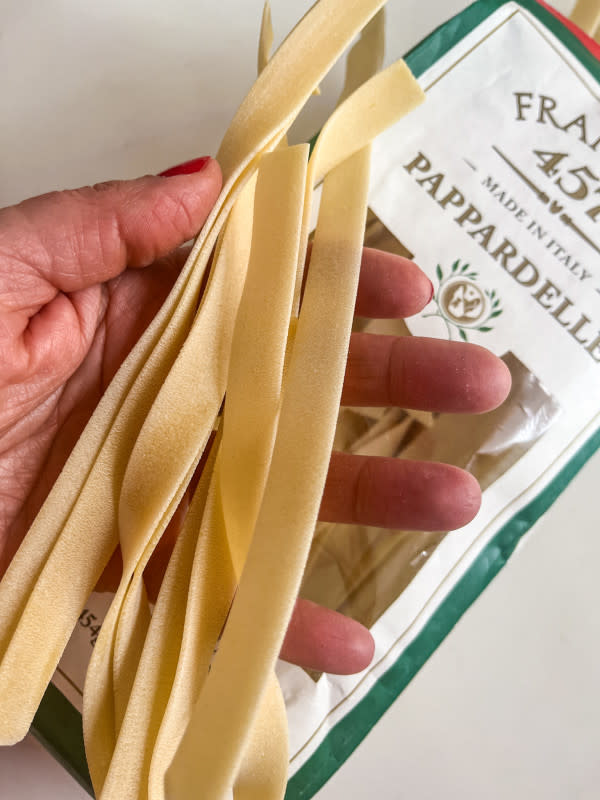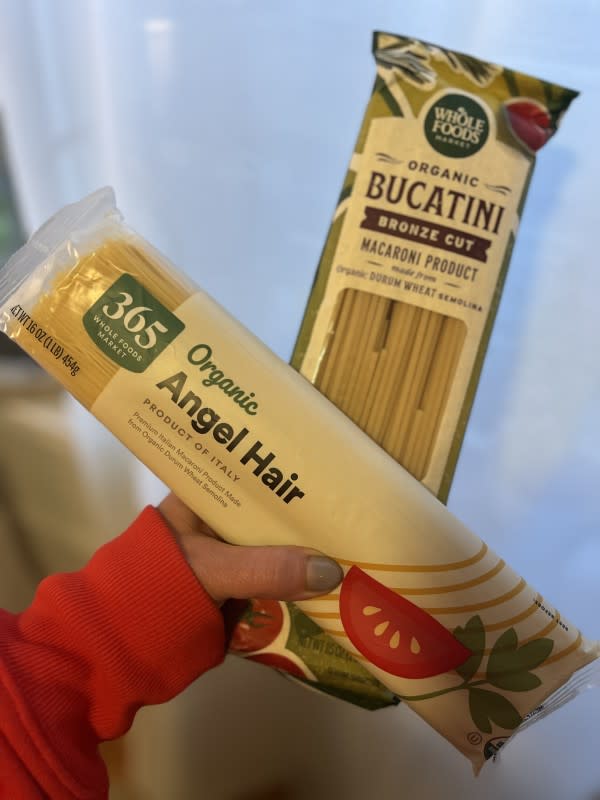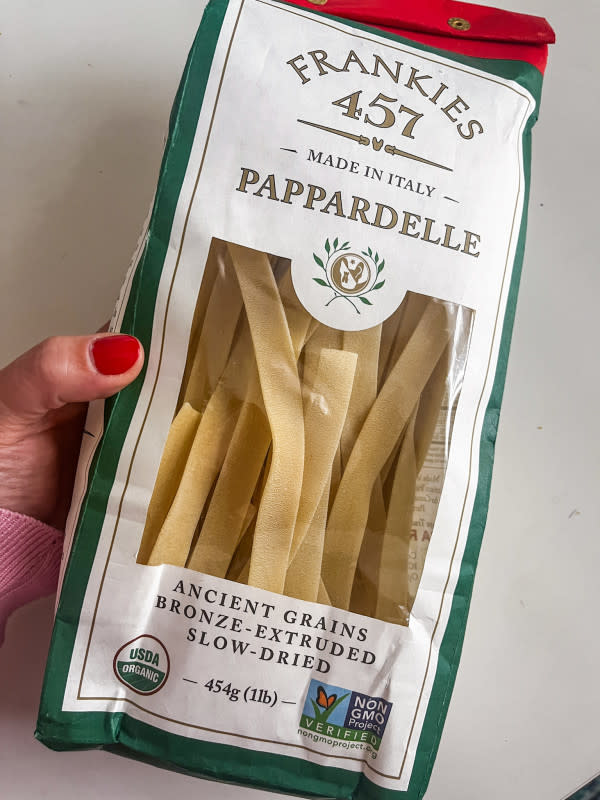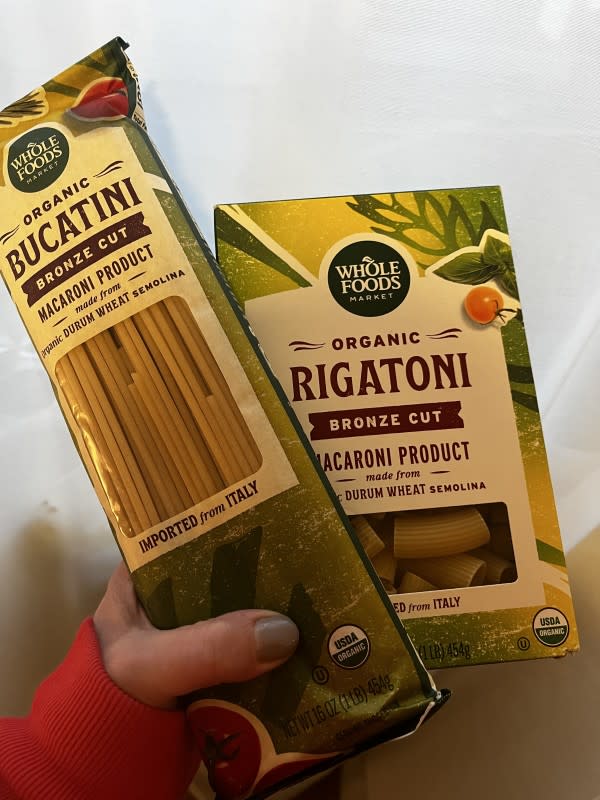What the Heck Is Bronze-Cut Pasta—and Is It Worth the Price?

Dried pastas
The supermarket's noodle section is full of endless pasta-bilities. There are tons of shapes and sizes and colors to choose from when you're trying to sort out what to boil or bake for your pasta dinner.
And now a newish term has entered the past chat: bronze-cut pasta. The higher-end noodle is showing up at places like Trader Joe's, Aldi and Kroger (among others) and Giada's new pasta line is bronze-cut, too.
But what's the difference between regular pasta and bronze-cut? What should you use it for? And is it worth the premium price? We went to pasta pros to get to the bottom of this carby conundrum. Read on to decide whether or not you should join the bronze revolution.
Related: Life-Changing Copycat Stouffer's Mac and Cheese
View the original article to see embedded media.
What is Bronze-Cut Pasta?
Dino Borri, the Global VP of Eataly, says that the most accurate terminology is actually “bronze-extruded” pasta and that it differs from the regular boxed stuff because it has a different production process and bronze-extruded pasta clings to sauce better than standard dried pasta.
Joe Isidori, a third-generation NYC Italian-American chef who owns Arthur & Sons in the West Village, also weighed in on the matter. "Bronze-cut pasta is higher quality pasta that is extracted using a bronze die and is not heated during extraction, giving you a rougher texture, which ultimately creates a more desirable consistency," he says.
If you've ever made pasta using a pasta machine, you know that the dough has to be extruded into whatever shapes you desire (sheets, elbows, penne, etc.). In commercial settings, the machine die is either coated in Teflon or bronze, with the former being cheaper and the latter being more traditional—and more expensive.
Michael Sabrin, a culinary expert, food scientist, and the Principal Product Developer for Whole Foods Market’s Exclusive Brands team, says that years ago, when looking for efficiencies in the process, manufacturers started lining their dies with Teflon to create a smoother surface to speed up the production. "This changes the pasta in several ways, but it also helped cut down on the cost of pasta because manufacturers were able to produce more," he says.
Borri notes that both fresh and dry pasta can be bronze-extruded. Fresh pasta, he says, which often contains eggs, is typical of the North of Italy and is made out of soft wheat flour. Dry pasta is typical in the South of Italy and made out of Durum wheat flour.
What's the Difference Between Bronze-Cut and Regular Pasta?
Bronze-cut pasta is just that—it's extruded from a bronze die instead of a Teflon one, changing the texture and consistency of the pasta itself. Borri says that you don't have to turn your nose up at pasta that isn't bronze-extruded, though, as Teflon-extruded pasta is still good.
"The most important thing when it comes to pasta is the quality of the wheat/flour that is used, in addition to the production method," he says.
My At-Home Bronze-Cut Pasta Taste Test
But all of this discussion was in theory. I was curious to know how the two types of pasta would fair in a side-by-side taste test.
The bronze-cut was, indeed slightly more textured and rougher, which caught the sauce way better than the regular. It tasted more "homemade" to me and I definitely preferred it over the regular.

Courtesy of Jessica Wrubel
The biggest difference was the bite—the bronze-cut stayed pleasantly chewy as it held onto the tomato sauce, and the regular noodles were a bit limp and slippery sauced by comparison. The bronze-cut pasta did produce a pasta water that was, indeed, cloudier and thicker than the regular. So I would imagine adding this to a homemade sauce would make it stick even better (which is kind of the point).
Related: The Magical Ina Garten Baked Pasta Recipe You'll Want to Make on Repeat
How Much Does Bronze-Cut Pasta Cost?
Bronze-cut pasta is going to be slightly higher, and that's due to the quality of the product. As Borri says "you pay the price for quality when it comes to pasta."

Courtesy of Jessica Wrubel
I placed an order for Whole Foods and opted for a Whole Foods brand organic angel hair, a bronze-cut bucatini and bag of slightly pricier Frankie's pappardelle (the bag said all the right things that the pros said to look for: "ancient grains," "bronze-extruded" and "slow-dried"). The Whole Foods bronze-cut pastas were $3.50, the regular was $1.99, and the Frankie's was $5.84, all 16 oz. Not bad for a "splurge" item.

Courtesy of Jessica Wrubel
However, take a slightly fancier product, Giada de Laurentiis' new pasta line, Giadzy. At $10.50 per box, you might wince at the price until you take a closer look and realize that the pasta is made with organic semolina flour and spring water from the Majella mountain range and the eight different shapes are cut with 100-year-old bronze dies.
Bronze-cut pasta can be found all over and doesn't have to cost $10.50 per box, though. Major grocery chains, including stores like Aldi and Trader Joe's, also sell bronze-cut pasta for a lower price.
View the original article to see embedded media.
Related: Giada's Chicken Piccata is Weeknight Dinner Perfection
When Should You Use Bronze-Cut Pasta?

Courtesy of Jessica Wrubel
Isidori (whose favorite pasta shape is rigatoni, by the way) says it's bronze-cut or bust. "You should always go for bronze-cut when working with dried pasta. Period," he says. "Its texture enables the sauce to cling to the pasta better and ultimately provides a superior mouth feel."
Borri agrees and says consumers should look for pasta from "the capital of dry pasta in Italy" which is Gragnano, in the region of Campania. "Gragnano is celebrated for its air-dried, bronze-extruded pasta across the world and since 2013, Pasta di Gragnano is a declared PGI (Protected Geographical Indication), meaning that the European Union has strict parameters for the production process to ensure its quality," he says.
Both Borri and Isidori prefer bronze-cut over regular pasta. For Borri, it's pasta that's from Gragnano (he mentions Afeltra is his go-to), and Isidori likes to pick up a box of De Cecco, a common higher-end grocery store brand that is fully bronze-cut and comes in some uncommon shapes, too, to make your bowl of pasta even more beautiful.
Sabrin notes that if the dish you're making is sauce-heavy, or if you're using the pasta water in your sauce as a thickening agent, bronze-cut pasta water is going to have more flavor and emulsification power because it's going to bring more structure to those sauces. The rougher bronze-cut pasta creates starchier pasta water and more starch = more sticking power in your sauce.
Next: 41 Easy Pasta Meals To Feed a Crowd and Have Leftovers for the Week
